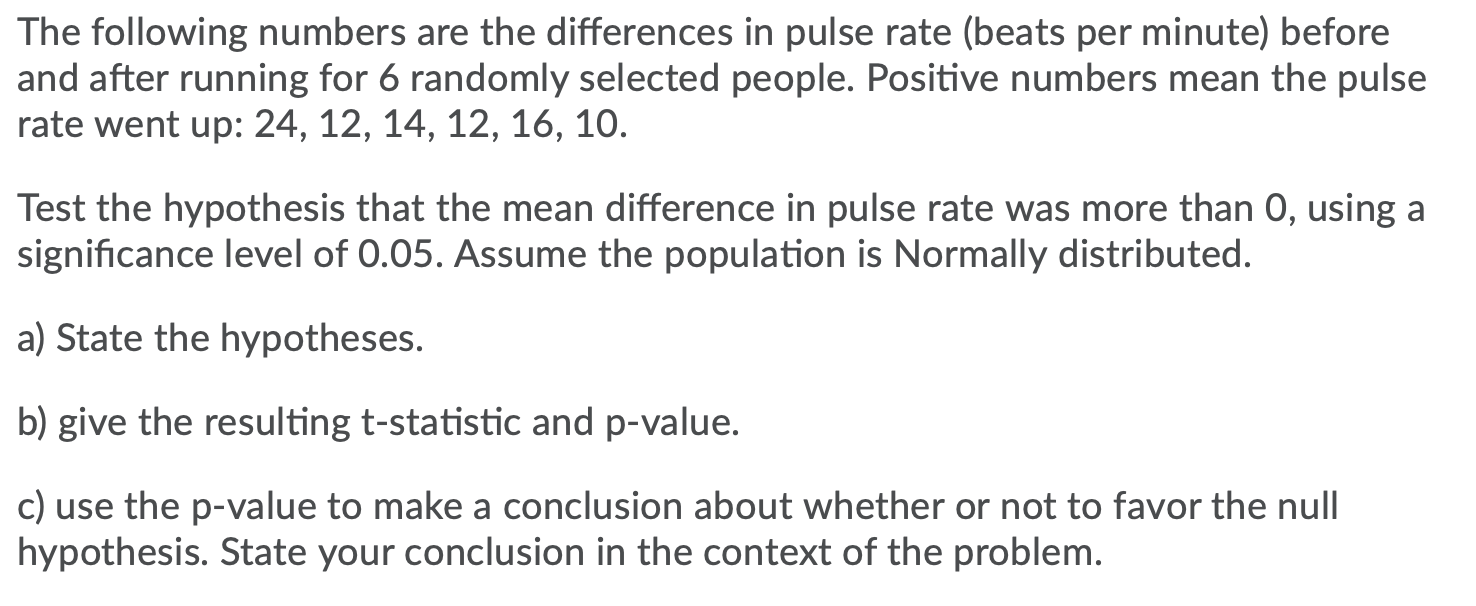The following numbers are the differences in pulse rate (beats per minute) before and after running for 6 randomly selected people. Positive numbers mean the pulse rate went up: 24, 12, 14, 12, 16, 10. Test the hypothesis that the mean difference in pulse rate was more than 0, using a significance level of 0.05. Assume the population is Normally distributed. a) State the hypotheses. b) give the resulting t-statistic and p-value. c) use the p-value to make a conclusion about whether or not to favor the null hypothesis. State your conclusion in the context of the problem.
The following numbers are the differences in pulse rate (beats per minute) before and after running for 6 randomly selected people. Positive numbers mean the pulse rate went up: 24, 12, 14, 12, 16, 10. Test the hypothesis that the mean difference in pulse rate was more than 0, using a significance level of 0.05. Assume the population is Normally distributed. a) State the hypotheses. b) give the resulting t-statistic and p-value. c) use the p-value to make a conclusion about whether or not to favor the null hypothesis. State your conclusion in the context of the problem.
Glencoe Algebra 1, Student Edition, 9780079039897, 0079039898, 2018
18th Edition
ISBN:9780079039897
Author:Carter
Publisher:Carter
Chapter10: Statistics
Section10.4: Distributions Of Data
Problem 19PFA
Related questions
Question

Transcribed Image Text:The following numbers are the differences in pulse rate (beats per minute) before
and after running for 6 randomly selected people. Positive numbers mean the pulse
rate went up: 24, 12, 14, 12, 16, 10.
Test the hypothesis that the mean difference in pulse rate was more than 0, using a
significance level of 0.05. Assume the population is Normally distributed.
a) State the hypotheses.
b) give the resulting t-statistic and p-value.
c) use the p-value to make a conclusion about whether or not to favor the null
hypothesis. State your conclusion in the context of the problem.
Expert Solution
This question has been solved!
Explore an expertly crafted, step-by-step solution for a thorough understanding of key concepts.
This is a popular solution!
Trending now
This is a popular solution!
Step by step
Solved in 2 steps with 2 images

Knowledge Booster
Learn more about
Need a deep-dive on the concept behind this application? Look no further. Learn more about this topic, statistics and related others by exploring similar questions and additional content below.Recommended textbooks for you

Glencoe Algebra 1, Student Edition, 9780079039897…
Algebra
ISBN:
9780079039897
Author:
Carter
Publisher:
McGraw Hill

Glencoe Algebra 1, Student Edition, 9780079039897…
Algebra
ISBN:
9780079039897
Author:
Carter
Publisher:
McGraw Hill